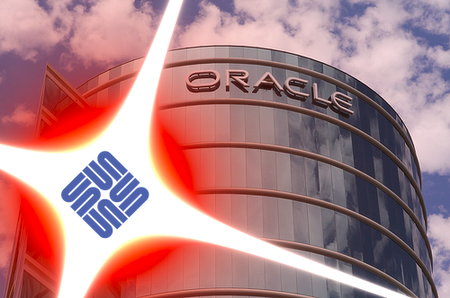
Sun Microsystems and Oracle Corporation announced today they have entered into a definitive agreement under which Oracle will acquire Sun common stock for $9.50 per share in cash. The transaction is valued at approximately $7.4 billion.
Oracle gets (among other things):
- Java (including NetBeans)
- Solaris
- MySQL
- SPARC
- VirtualBox
Oracle already has:
- Oracle database
- Oracle application server
- JDeveloper and SQL Developer
- eBusiness Suite / Peoplesoft / Siebel / J.D. Edwards
- Unbreakable Linux (which is an Oracle-supported Redhat Enterprise Linux)
I wonder what the Google, IBM and Microsoft guys are thinking right now… This acquisition has the potential to be a masterstroke in our era of utility computing:
Utility computing is the packaging of computing resources, such as computation and storage, as a metered service similar to a traditional public utility (such as electricity, water, natural gas, or telephone network). This system has the advantage of a low or no initial cost to acquire hardware; instead, computational resources are essentially rented. Customers with very large computations or a sudden peak in demand can also avoid the delays that would result from physically acquiring and assembling a large number of computers.
and cloud computing:
Cloud computing is a style of computing in which dynamically scalable and often virtualised resources are provided as a service over the Internet. Users need not have knowledge of, expertise in, or control over the technology infrastructure “in the cloud” that supports them. The concept incorporates infrastructure as a service (IaaS), platform as a service (PaaS) and software as a service (SaaS) as well as Web 2.0 and other recent technology trends that have the common theme of reliance on the Internet for satisfying the computing needs of the users.
I can easily imagine Oracle using hardware technology from Sun and Solaris to provide utility computing services (Sun already has a grid.) And, of course, I can easily imagine Oracle deploying its business suites (eBusiness Suite / Peoplesoft / Siebel / J.D. Edwards) and a lot of other applications on that infrastructure.
Exciting times ahead. Let’s hope that everything which is open source remains truly open source.



As I said earlier, Open Source (esp. Linux) is the future over platforms like Android and the new Sun/Solaris infrastructure with Oracle solutions will be giving all this a major boost. I’m eagerly waiting to see what they’ll be building in terms of SOA, IaaS, PaaS and SaaS. Virtualisation along with computer clusters are gaining ground now and its all for the best.
i wonder if mysql will still remain opensource.
Nice strategy by oracle btw, its almost like total world domination.
I wonder what would be Oracle’s stand regarding MySQL.
Two big things to come out of this: cloud computing and SaaS. Of course, powered by the myriad of development tools that come out of the acquisition. Linux and OpenSolaris are largely irrelevant as far as serious money-making is concerned, but they are good selling points for the rest of what is on offer.
Suddenly, Google looks like an underdog, what with Oracle/Sun and Microsoft being the big boys who are all enterprisey.
Eddy.
héhé
sed -e ‘s/mysql/sqlplus/g’ ….
Hello Sir,,
previously when we need to install java on a machine(OS: Windows) we need to install first JVM and the JDK.
Now when installing Java we require only JDK.
Does JDK include JVM ?
thank you
Yes. The JDK includes the JRE (JVM + libraries) and the development tools (java, javac, etc.)
Need to pay to see the SUN now. :-)
Hello Sir,
With aspects to database,
A view logically represents subsets of data from one or more tables.
We can use select statements to query the view.
Where is the VIEW stored???
A view is not a subset of the data. Rather it is a query which is executed each time the view is accessed. The data only exists in tables (i.e. relations.)
Question:
Can you update the data in a view?
Answer:
A view is created by joining one or more tables. When you update record(s) in a view, it updates the records in hte underlying tables that make up the view.
So, yes, you can update the data in a view providing you have the proper privileges to the underlying tables.
Question:
Does the view exist if the table is dropped from the database?
Answer:
Yes, in Oracle, the view continues to exist even after one of the tables (that the view is based on) is dropped from the database. However, if you try to query the view after the table has been dropped, you will receive a message indicating that hte view has errors.
If you recreate the table (that you had dropped), the view will again be fine.
My question is Where does the view resides in the computer?
your blog is not interesting
its not really interesting.more informatin is needed
To Sanjive asking “My question is Where does the view resides in the computer?”
The view is just a bunch of metadata (basically the SQL query and permissions) residing in the database schema somewhere… What is important is that the view gets its data from existing tables and, as you wrote above, views (sometimes) allow for writes (this depends of course on satisfying all integrity constraints etc.)
To ram and sandrine who are the same person as proved by your IP address of 41.136.244.225:
You are a moron. And somewhat stupid for not knowing about IP addresses. Furthermore, you seems to be schizophrenic as you think you are two different people at the same time. And finally you are not sure about your exact sex hence Ram for 1 second and Sandrine next. I guess you should go and see, say, a disciple of Freud. Or, better, for both of us: f*ck off from my blog :-)
Thanks a lot….
u a genius sir…
That’s way too much, Sanjive!
I am just very intelligent and extremely helpful, that’s all :-)
avinash teaching dbms now?
coming back to the oracle/sun thread….
working for a sun & oracle partner in the region, i must say, that this was a very nice move from oracle…
just imagine the possibilities, oracle coders working with the java and solaris coders, amazing stuff like DB appliances, ERP in a box, plug and play BI, coming out…
from a business perspective also, this acquisition is gonna be a killer, IBM gonna face some serious drawbacks on the long run… now that oracle is taking in sun, the licensing model for the sun t-series servers will probably change, and for those who have paid oracle licenses, you know what a pain this has been…
frankly i’m still in awe over that news… though it will mean more competition for me around…
Just reading your blog about oracle and the acquisition of Sun and CRM solutions. Now I’m no real expert in CRM solutions since I never really worked with SAP but I do make my living from both Siebel and SFDC…
It might be suggested that Oracle should stick to its excellent database. In terms of its Saas application, i.e Siebel or now re-packaged as Oracle on Demand, this for a start is not a real Saas application since it doesn’t support multenancy…
SFDC on the other hand is a small, new and highly dynamic company… For all those of us who are not as versatile with setting up a platform environment, especially when it comes to a work environment, I firmly believe that SFDC is the future, not Oracle on demand.
I have been using Siebel for quite some time and am on the opinion that it’s ok when operating in a single tenancy environment. Then I started using SFDC: whoosh! That takes the whole idea of Saas or PaaS to a completely new level. Suddenly it looks like anyone can do this, suddenly it appears that one does not have to even have the most basic knowledge of any programming or Sql to make this thing work.
Also, which is the best part of the bargian: you don’t even have to look after the application, or the servers or the updates: someone else does it for you and at a minimal cost. And that someone else does it better than you because they are experts and are determined to make your life a lot easier. Not to say that they want you to actually focus on doing your job…
SaaS and PaaS, and cloud computing are exciting news. However, with the likes of SFDC and Oracle on demand, are we going to see the end of an era of huge IT departments in organisations?
I firmly believe that Cloud computing will considerably reduce oversized IT departments, as we no longer will need a whole department looking after servers in an organisation, since those will be looked after by our SaaS or PaaS provider…
And although I think that Oracle does many excellent things, in the SaaS market, I personally see the future as being SFDC. And Eddy, sorry to burst your bubble, cloud computing and Saas are big things that came from SFDC, not Oracle…